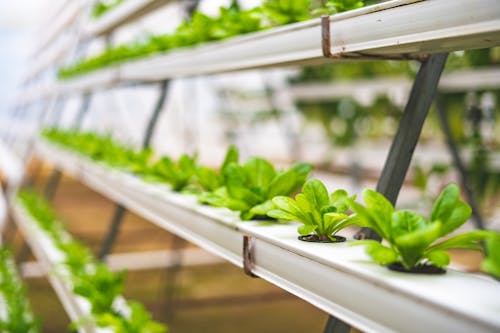
Are you looking for an efficient, profitable, and sustainable way to grow your food? If so, then vertical hydroponic farming could be the answer. Hydroponic vertical farming is a method of growing plants in nutrient-enriched water instead of soil, vertically stacked on top of each other.
This system allows you to maximize land space and provide consistent crop yields year-round. This blog post will explore the benefits and steps involved in setting up your vertical hydroponic farm!
What Is A Hydroponic Vertical Farming System, And How Does It Work?
A hydroponic vertical farming system utilizes closed-loop systems to grow plants without needing soil, instead relying on water and other nutrients. This method can be used indoors or outdoors and uses stacked containers filled with nutrient-rich water to facilitate plant growth. Vertical farming systems can grow various crops in high-density spaces, including fruits and vegetables.
The hydroponic system delivers nutrient-rich water directly to the roots of plants through tubes or channels in each container. This allows for efficient use of space and prevents soil from becoming compacted or laden with weeds. Additionally, since the water is constantly oxygenated, there’s no need to worry about plant roots becoming waterlogged.
Benefits Of Using A Hydroponic Vertical Farming System
Using a hydroponic vertical farming system is becoming increasingly popular as more people look for efficient and sustainable ways of raising crops. Hydroponics involves cultivating plants in water enriched with essential nutrients instead of soil, eliminating the need to till or plow the land and allowing for higher crop yields in less space than traditional farming methods. Here are some of the benefits of using a hydroponic vertical farming system:
- Reduced water usage – Since plants grown in hydroponics use just one-tenth of the water required for traditional soil-based farming, it greatly reduces the overall water used. This can benefit regions with limited access to water or those experiencing drought conditions.
- Reduced space requirements – By growing crops vertically, up to 10 times more crops can be produced on the same land compared to traditional farming methods. This allows farmers to maximize their yield while using less land and resources.
- Easier pest control – It is easier to control pests with hydroponic systems since the water used for the plants are often treated or sterilized, eliminating potential pest problems.
- Reduced risk of soil-borne disease – Since plants are grown in a sterile environment, they are less likely to become infected with soil-borne diseases that can be problematic in traditional farming.
- Increased crop yields – Hydroponic systems are designed to maximize crop yield, allowing farmers to get more out of each growing season.
- Reduced environmental impact – With hydroponics, there is no need for chemical fertilizers or pesticides, making it an environmentally sustainable option for producing food. The reduced water usage also helps reduce the strain on natural resources.
How To Set Up A Hydroponic Vertical Farming System?
Once you’ve chosen a suitable location for your vertical farming system, you’ll need to set up the necessary components.
For most systems, this will include a tank or reservoir filled with nutrient-enriched water, irrigation lines running from the tank to each of your plant beds, and an air pump or other aeration system. Depending on the type of plants you’re growing, and how much you want to automate your system, you may also need a timer for controlling light cycles and additional pumps or valves.
Once all your components are properly installed, it’s time to plant. The best way to do this is by first adding a layer of inert material to the growing bed, such as perlite or gravel.
This will provide drainage and support for your plant’s roots, allowing them to access the water and nutrients they need without becoming waterlogged or root-bound. You can then carefully add your seedlings or cuttings to the bed and adjust the irrigation lines (if necessary) to ensure each plant gets the right water.
Finally, you’ll need to monitor your hydroponic vertical farming system on a regular basis. This means checking things like pH and nutrient levels and making necessary adjustments.
It also involves checking out for any pests or diseases that may have found their way in and taking action to remedy any problems as soon as possible. With regular maintenance and monitoring, you should be able to enjoy a successful harvest from your vertical farming system.
Things You Need To Consider Before Setting Up Your Own Hydroponic Vertical Farming System:
Once you have determined that a hydroponic vertical farming system is the best route for your home or a commercial operation, several factors must be considered before setting it up.
Space: The size and shape of your farm will depend on what kind of plants you plan to grow. Consider both indoor and outdoor spaces when planning the layout of your system. Make sure to factor in sufficient ventilation and lighting for the plants you plan to grow and space to accommodate equipment such as pumps and nutrient tanks.
Nutrients: In hydroponic farming, nutrients are needed for the plants to thrive. A good quality nutrient solution is necessary for healthy plant growth. Consider the type of nutrient solution you will use and how it will be delivered to your plants.
Lighting: Plants need light to grow, so you must ensure that your space is well-lit. You should also consider what lighting system works best with your plants, such as LED or high-intensity discharge (HID) lights.
Water: Hydroponic farms need a constant supply of clean water and a way to filter and recycle the nutrient-rich solution. Consider what type of water you will use, how it will be delivered to the plants, and how often you will need to replenish it.
Pest Control: Insects and other pests can quickly ruin your crop, so you must plan for pest control measures. Consider what types of natural or chemical methods you will use to keep pests at bay.
Automation: Whether working with a large home system or a commercial-scale operation, automation can help you save time and energy. Consider what type of automated technology works best with your system, such as automated watering systems, nutrient delivery systems, and climate control systems.
Maintenance: Hydroponic vertical farming requires occasional maintenance to keep it running smoothly. Consider who will be responsible for the upkeep of your system and how often it will need to be serviced.
Conclusion
It is easier than ever to set up your own hydroponic vertical farming system at home. With a little research and some basic supplies, you can be well on your way to enjoying the many benefits of fresh, healthy produce all year round. If you have any questions or need help getting started, please don’t hesitate to contact us. We would be more than happy to assist you in setting up your own hydroponic vertical farm.
